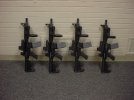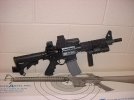Conventional Wisdom suggests the brighter the better for a light used for personal defense or integrated as a weapon mounted system. Generally if one is using the bright light in a forested area against four legged predators then perhaps there is some truth to this wisdom. But if you're using the light for self defense against two legged predators in an urban environment or enclosed environment (parking lot, inside/around a truck/vehicle, building, alley etc) then "brighter is not always better." In fact it actually works against you.
Let's get real here...for most (including law enforcement)...the typical defensive engagement is anywhere from contact distance to 10 yards max. Rarely is it much beyond 10 yards. Extremely rarity is shooting across the street...and if you're doing that then you'll have a lot of explaining to do to a jury (especially in civil court) why you just didn't drive away, walk away, or ensconce oneself in a nearby building hunkering down behind protective cover. Also unless you're in a forested area most of America has some ambient light. So we're not generally in complete and total darkness. We just need enough light to see the potential or actual threats hands and to determine if we have AOJ.
Everything is a trade-off...the brighter you go with a light then it does two things negatively working against you...first it negatively affects your eyes ability to adjust and work in a darker to partially lighted environment. Again, there is probably already some ambient light you eyes can work with. The eyes are re-adjusted to much more light and when the light goes off then you'll experience some level of night blindness. Remember the light shouldn't be on more than a couple seconds, then you turn it off, move and turn back on as needed.
Secondly. brighter lights tend to produce a larger and brighter corona and that spills over onto your cover making you easier to be seen by the threats or potential threats and worse yet the reflection from the corona actual reduces your ability to see much more than a few feet in front of you. I've seen people using these mega lumen lights blind themselves when working around white/tan walls or metalic siding or vehicles. The corona reflects off of the wall or vehicle blinding them so badly it takes them out of the drill/fight.
So in some cases...brighter isn't always better. I always suggest people test their gear in a Low Light type defensive firearms course first with a seasoned instructor and where you can experiment with various light systems. You'll be amazed at what you'll discover and it will erode many common misconceptions about defending oneself at night and using lights.
Perhaps a more important question to ask is do I want LED or Incan for a light? Generally what we've found with our testing is LED is very good but not as effective in penetrating fog, mist, smoke, or a haze.
But what the heck do I know?








